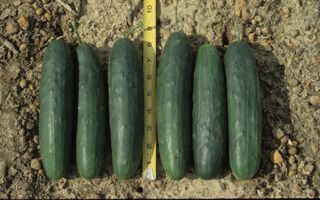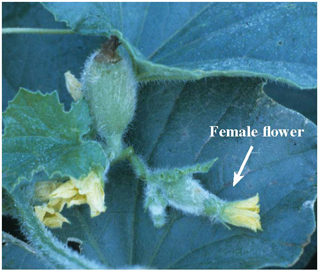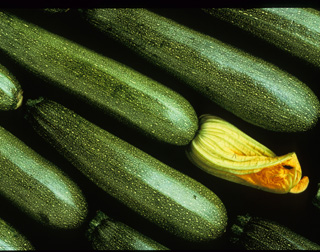G1754
Bee Pollination of Cucurbit Crops
Fertilized soil, irrigated crops and pest control may not be enough to produce a quality cucurbit crop, if you’ve also had poor pollination. Use this guide to find out more about bee pollination of cucurbit crops and the value of good pollination.
Laurie Hodges, Extension Vegetable Specialist
Fred Baxendale, Extension Entomology Specialist
|
Closely examine the fruit. If seeds are not fully developed, poor pollination may be responsible. While adverse temperatures can reduce pollen viability and reduce pollination effectiveness, a more common problem is insufficient bee activity for adequate pollination.
Melon and cucumber flowers are pollinated exclusively by honey bees and other insect pollinators. They are not wind- or self-pollinated. Insects are required for pollen transfer because of the large size of the pollen grains, their stickiness, and the way they are released from the anthers.
Also, since these plants typically produce only small amounts of pollen, pollinators are needed to efficiently transfer pollen from one flower to the next. While wild bees or distant honeybee colonies may suffice for small melon or cucumber fields, they may be inadequate for the commercial grower whose income depends on substantial yields of high quality fruit. Maximum yields harvested in a minimum number of trips across the field is economically advantageous. To accomplish this, good pollinator activity is essential.
|
Flower Types: There are three flower types in cucurbits: male only, female only, and combination flowers containing both male and female components. Most muskmelon varieties produce male flowers at the beginning of the season and continue to produce them throughout the season. Female flowers and the occasional combination flowers appear in response to longer days, generally 10-14 days after the first male flowers. These flowers occur on branch runners. Fruit develops from the female flowers and the combination flowers. Even in combination flowers, insects are needed to carry pollen to the female parts (stigmata).
Older cucumber varieties produce flowers in a manner similar to that of muskmelon — male flowers followed by female flowers. Newer varieties, called “gynoecious types,” produce only an abundance of female flowers. Another variety that produces male flowers is combined with the gynoecious variety at a rate of 10-15 percent of the total seed to provide pollen (a “blender” variety). This random mix of the pollinator variety among the gynoecious plants is enough to set fruit if enough bees are available to transfer the pollen.
Watermelons initially produce male-only flowers and continue producing them throughout the rest of the season. Female-only flowers are produced later in the season at specific positions along the vine in response to longer days.
Squash and pumpkin also require bee pollination and the appearance of male and female flowers occurs in response to day length, similar to the other cucurbits.
Good Pollination for Good Fruit: The individual flowers of cucurbits remain open only for a single day. If they are not pollinated during that time, the flowers abort and drop from the vine. When incomplete pollination occurs, fruit do not develop properly. Because many seeds form within each fruit and each pollen grain is responsible for the development of a single seed, inadequate pollination results in small or misshapen fruit and low yields of marketable fruit.
Researchers have found that it takes at least nine honeybee visits per flower to pollinate cucumbers adequately. Since each bee will visit about 100 flowers per foraging trip, usually at least one strong hive per acre is required. Bees are most efficient if they can forage within 200 yards of the hive.
Honeybee colonies should be moved into position near the field about the time the first female flowers are seen (Figure 2). If the bees are moved in too early, they may find other attractive flowering plants in the area and not work the cucurbits. Hives can be removed from melon fields when flowering begins to diminish or when the vines begin to break down. Leave colonies in cucumber fields until a day or so before the last picking (Figure 3).
Care of Bees: In most areas, bees can be rented from a local beekeeper. A written agreement between the grower and bee supplier is advisable and should clearly explain each party’s responsibilities and the procedures to follow regarding pesticide applications. Optimally, colonies should be located on two or three sides of fields up to 30 acres in size. An ideal location is one that exposes the hives to early morning sun and provides some shade at mid-day. Only strong colonies should be selected for pollination purposes. A strong colony will contain enough bees to cover 10 to 20 frames and brood in eight or more combs. Bees should be provided with a nearby water source such as a trough of water. Place a piece of wood or other floating object in the trough for the bees to rest on while drinking.
Protecting Bees from Pesticide Poisoning: Growers need to be aware that pesticides used to control insects in the field also may be hazardous to bees. Many of the commonly used products remain toxic for up to 24 hours or more after application!
ALWAYS READ, UNDERSTAND AND |
The risk of bee kills can be reduced by applying pesticides late in the evening after bees have completed foraging and by not spraying when dew is heavy. When the option exists, use pesticides with the lowest possible toxicities to bees. Generally, wettable powders and dusts are more toxic to bees than emulsifiable formulations. When feasible, plan to control insect pests before moving bees into the fields.
Visit the University of Nebraska–Lincoln Extension Publications Web site for more publications.
Index: Crop Production
Field Crops
Issued October 2007


